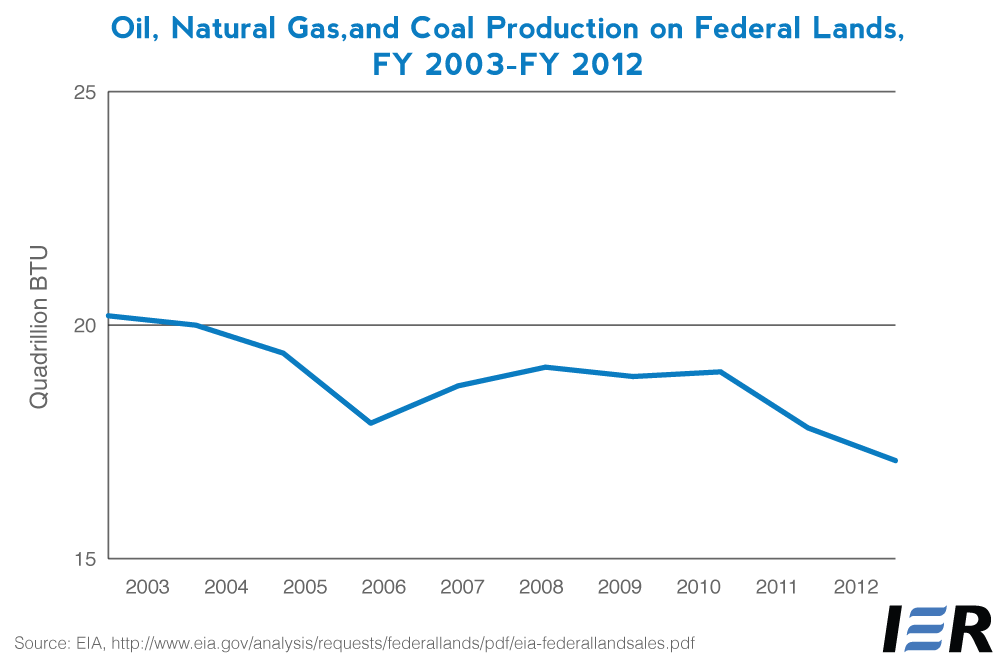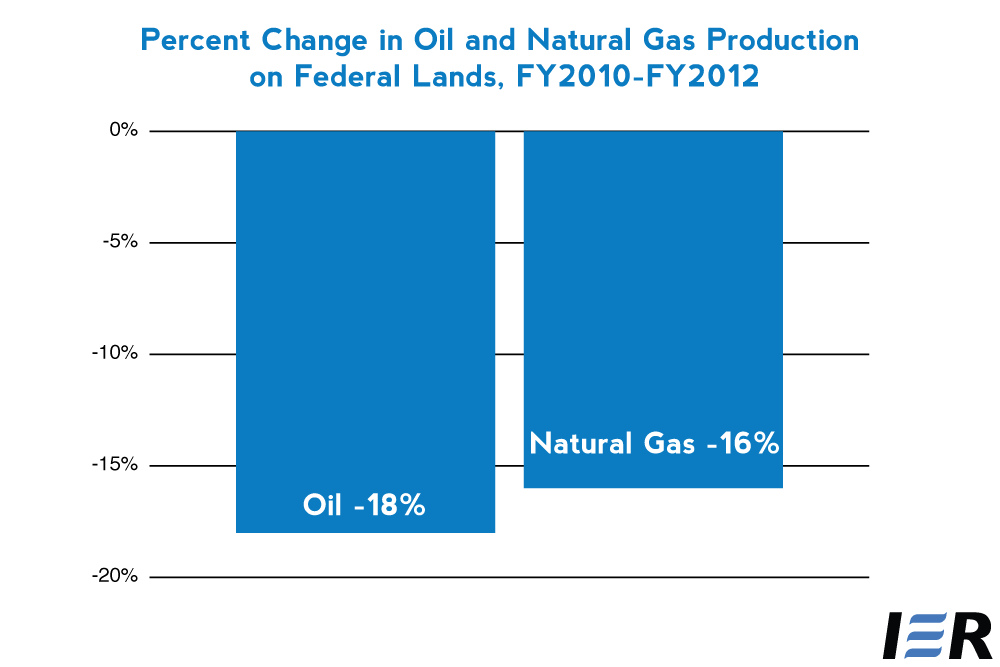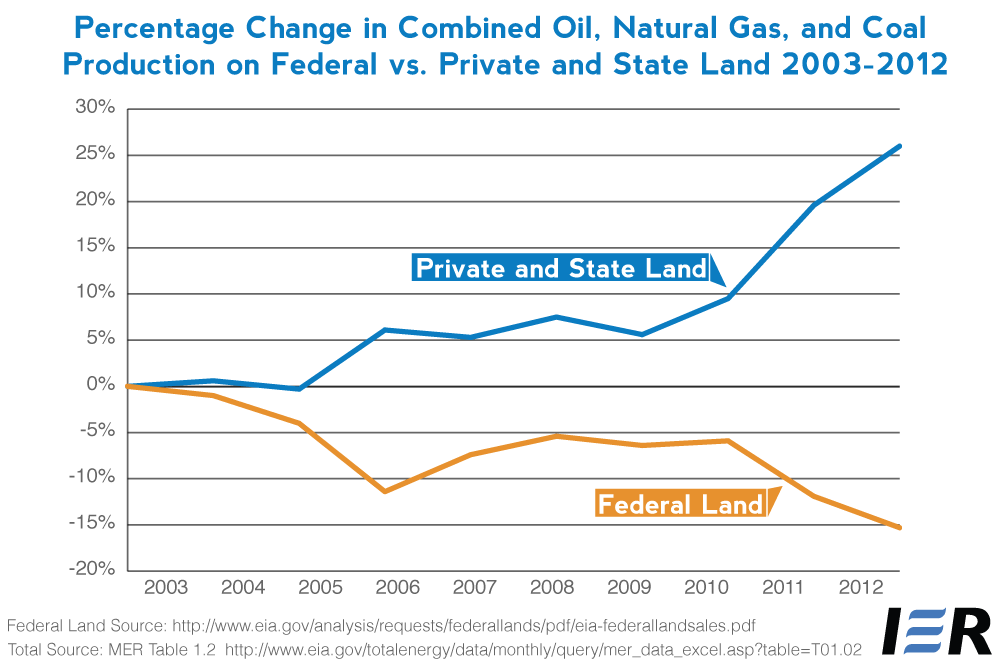The Energy Information Administration (EIA) just released its report, Sales of Fossil Fuels Produced on Federal and Indian Lands, FY 2003 Through FY 2012.[i] This report shows that total fossil fuel production on federal lands is at a ten year low, natural gas production on federal lands is also at a ten year low, and oil production on federal land fell in fiscal years 2011 and 2012 ending two years of increase in fiscal years 2009 and 2010. Specifically the new EIA report shows:
- Fossil fuel (coal, oil, and natural gas) production on Federal lands is the lowest in the 10 years EIA reports data and was 4 percent less in fiscal year 2012 than in fiscal year 2011.
- The share of fossil fuels produced on federal lands has declined from 36. 1 percent in fiscal year 2003 to 27.6 percent in fiscal year 2012.
- Crude oil and lease condensate production on Federal lands was 18 percent lower in fiscal year 2012 than in fiscal year 2010 when it reached its peak of 723 million barrels.
- Natural gas production on Federal lands is the lowest in the 10 years that EIA reports data and was 7 percent lower in fiscal year 2012 than in fiscal year 2011.
- Natural gas plant liquids production on Federal lands was 6 percent lower in fiscal year 2012 than in fiscal year 2010, when it reached its peak of 121 million barrels.
- Coal production on Federal lands was 8 percent lower in fiscal year 2012 than in fiscal year 2008 when it reached its peak of 483 million short tons.
Fossil Fuel Production on Federal Lands
Crude oil production on Federal lands decreased 18 percent from 723 million barrels in fiscal year 2010 to 596 million barrels in fiscal year 2012. Production of crude oil on Federal lands is dominated by offshore production, which fell by 23 percent in fiscal year 2012 from its peak in fiscal year 2010 of 615 million barrels, mostly notably due to government actions taken following the oil spill in the Gulf of Mexico in 2010. These actions include a moratorium on offshore drilling by the Obama Administration, followed by a permit moratorium that slowed oil and gas companies from returning to their normal rate of drilling. While the Obama administration has leased new offshore areas to drilling, its offshore plan for fiscal years 2012 to 2017 only offers those areas that were available for leasing prior to President Bush’s removal of the executive moratorium on offshore drilling and Congress’ removal of its moratorium on offshore drilling in 2008. The vast majority of areas of in the offshore United States remain off limits to leasing during the next 5 years, and even those areas identified by the Department of Interior are referred to as “potential” lease sales, implying their leasing future is uncertain.
Source: Energy Information Administration, http://www.eia.gov/analysis/requests/federallands/pdf/eia-federallandsales.pdf
Natural gas production on Federal lands decreased every year since fiscal year 2003, the earliest fiscal year EIA reported data. In fiscal year 2012, natural gas production on Federal lands was 4,262 billion cubic feet, 7 percent less than in fiscal year 2011, and 37 percent less than in fiscal year 2003. Offshore natural gas production volumes have been on a consistent downward trend for the last 10 years, and are 70 percent less in fiscal year 2012 than in fiscal year 2003.
Natural gas plant liquids production on Federal lands peaked in fiscal year 2010 at 121 million barrels and declined to 114 million barrels in fiscal 2012, down 6 percent.
Coal production on Federal lands peaked at 483 million short tons in fiscal year 2008 and decreased each year since then. In fiscal year 2012, coal production on Federal lands was 442 million short tons, down 8 percent from its peak in fiscal year 2008.
Source: Energy Information Administration, Sales of Fossil Fuels Produced on Federal and Indian Lands, FY 2003 Through FY 2012, May 2013, http://www.eia.gov/analysis/requests/federallands/pdf/eia-federallandsales.pdf
Federal vs. Private and States Production
While it is striking how much combined oil, natural gas, and coal production has fallen on federal lands, especially given the fact that federal lands contain vast amounts of energy resources, what is more striking is comparing production on federal lands to production on private and state lands.
While production has dramatically fallen over the past decade on federal lands, the hydraulic fracturing revolution has led to dramatically increasing oil and natural gas production on private and state lands as shown in the chart below.
Conclusion
The big picture is clear that government policies undertaken by the Obama Administration have produced a significant decline in offshore oil production on federal lands in fiscal years 2011 and 2012. That is certainly not a way to increase domestic production of oil and keep oil and thus gasoline prices in check. This is especially pronounced against a backdrop of the most rapidly increasing oil production in United States history, which is happening on those private and state lands where the federal government is not managing the program.
[i] Energy Information Administration, Sales of Fossil Fuels Produced from Federal and Indian Lands, FY 2003 Through FY 2012, May 2013, http://www.eia.gov/analysis/requests/federallands/pdf/eia-federallandsales.pdf






